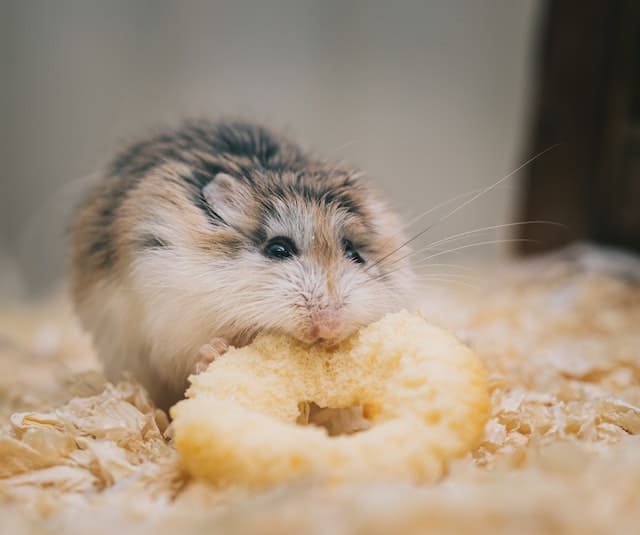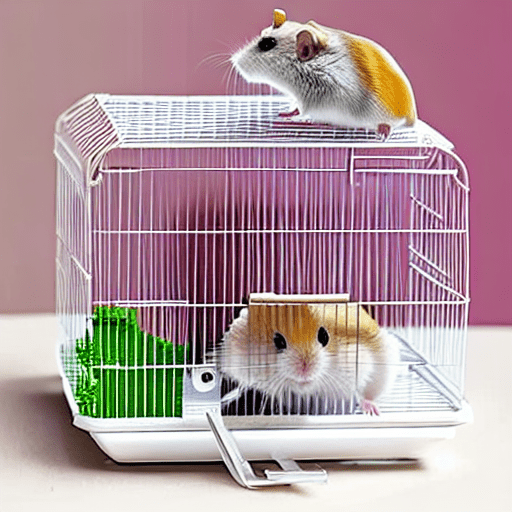How to Tell If a Hamster is Pregnant: Expert Tips Revealed!
Physical Changes In A Pregnant Hamster
Physical changes in a pregnant hamster can help you determine if your furry friend is expecting. One noticeable change is weight gain. Pregnant hamsters tend to gain weight rapidly as their pregnancy progresses. The abdomen also becomes visibly enlarged as the embryos develop. Keep a close eye on your hamster’s eating habits. A pregnant hamster may have an increased appetite due to the growing babies inside. Additionally, check for swollen nipples, as this is a common sign of pregnancy. These changes in a pregnant hamster’s appearance are key indicators to look out for if you suspect your pet may be pregnant.Behavioral Changes In A Pregnant Hamster
If you notice behavioral changes in your hamster such as nesting, weight gain, or aggression, it may be a sign that she is pregnant. Look for physical cues like a swollen abdomen or enlarged nipples to confirm your suspicions. A pregnant hamster may exhibit several behavioral changes, indicating her condition. One noticeable behavioral change is nest building behavior. Pregnant hamsters instinctively begin creating a cozy nest using bedding materials such as shredded paper or straw. This behavior is a sign that she is preparing for the arrival of her litter. An increase in urination is another common sign of pregnancy in hamsters. As the pregnancy progresses, the hormonal changes can lead to increased urine production. This change may be noticeable when cleaning the hamster’s bedding. Pregnant hamsters often experience a decreased activity level. They may appear less active or spend more time resting in their nest. This change is due to the physical changes and discomfort associated with pregnancy. Aggression or irritability may also be observed in pregnant hamsters. Hormonal fluctuations can affect their mood, making them more defensive or aggressive. It is important to handle pregnant hamsters with care and avoid any sudden movements or loud noises that could stress them further.Health Considerations For A Pregnant Hamster
One way to determine if a hamster is pregnant is to consider the health factors. During pregnancy, it’s important to ensure the hamster has increased fluid intake. This can be observed by monitoring their water consumption and providing fresh water at all times. Additionally, adequate nutrition is crucial to support the mother’s well-being and the development of the babies. A balanced diet consisting of a variety of fruits, vegetables, grains, and high-quality hamster pellets is recommended. Regular veterinary check-ups are essential during a hamster’s pregnancy. A professional can perform thorough examinations and provide guidance on proper care and potential complications that may arise. It’s important to monitor for any signs of distress or unusual behavior. Potential complications during hamster pregnancy can include dystocia, which is difficulty giving birth, as well as nutritional deficiencies or diseases. It’s important to be aware of the signs of these complications, such as lethargy, loss of appetite, or difficulty breathing. If any concerns arise, contacting a veterinarian immediately is highly recommended.Monitoring The Progress Of Pregnancy
Monitoring the progress of pregnancy in a hamster involves tracking the time since mating, observing the growth of the abdomen, noting any unusual symptoms, and consulting with a veterinary expert if needed. Tracking the time since mating is crucial in determining if a hamster is pregnant. Female hamsters have a gestation period of around 16-18 days, so counting the days since mating can give an indication of whether she may be pregnant. Observing the growth of the abdomen is another way to tell if a hamster is pregnant. As the pregnancy progresses, the abdomen of the female will gradually expand. It is essential to handle the hamster gently and look for any signs of a growing belly. Noting any unusual symptoms is important as well. Pregnant hamsters may display behavioral changes, such as nesting behaviors, increased appetite, and lethargy. These symptoms can provide further clues about the pregnancy. If there is any doubt or concern, it is recommended to consult with a veterinary expert. They can perform a thorough examination and confirm if the hamster is indeed pregnant, as well as provide guidance on taking care of the expectant mother.Confirming Pregnancy In Hamsters
When determining if a hamster is pregnant, there are several methods that can be used to confirm the pregnancy. One way is through palpation and feeling for lumps. By gently and carefully feeling the hamster’s abdomen, small lumps may be detected, indicating the presence of developing embryos. Another method is through ultrasound examination. This non-invasive procedure allows the veterinarian to visualize the internal reproductive structures of the hamster, providing a more accurate confirmation of pregnancy. X-ray imaging can also be used to identify pregnancy in hamsters. This method can often provide a clear visualization of developing fetuses, making it an effective diagnostic tool. A blood test for hormone levels is another option for confirming pregnancy. This test can detect specific hormones that are produced during pregnancy, providing a definitive confirmation.Preparing For The Birth Of Baby Hamsters
Preparing for the Birth of Baby Hamsters Creating a Comfortable Birthing Environment: To ensure a smooth and stress-free birth for your hamster, it’s essential to create a comfortable birthing environment. Start by providing adequate nesting materials such as soft bedding, shredded paper, or tissue, as these will help the mother hamster build a cozy nest for her babies. Additionally, make sure to place the nesting area in a quiet and calm part of the cage to minimize any disturbances that could stress out the mother. Familiarize yourself with the birthing process so that you can be prepared and know how to assist if needed. Remember, a well-prepared and supportive environment will help your pregnant hamster feel safe and secure during the birthing process.Caring For The Pregnant Hamster And Newborns
Caring for a pregnant hamster and her newborns requires special attention and care. Monitoring the hamster’s diet and exercise is crucial during pregnancy. Ensure the pregnant hamster is provided with a balanced and nutritious diet, rich in fresh vegetables, fruits, and high-quality hamster feed. Avoid overfeeding and give small portions of food more frequently. Provide ample fresh water and remove any uneaten food from the cage to maintain cleanliness. Handling the hamster with care is essential to avoid unnecessary stress or harm. Limit unnecessary handling during gestation, but when needed, make sure to support the hamster’s body gently and avoid squeezing the abdomen. Observing the health of the newborns regularly is important. Monitor their growth, check for any signs of distress or abnormalities, and ensure they are nursing properly. If any concerns arise, seek advice from a veterinarian experienced in small animal care. Supporting the mother with extra care is vital for her well-being and the health of her offspring. Provide a quiet and stress-free environment, away from loud noises or sudden disturbances. Regularly clean the cage and bedding, and ensure the temperature is consistent and appropriate.FAQ’s About Hamster Pregnancy
Hamster pregnancy can be detected through physical signs such as weight gain, nesting behavior, and nipple enlargement. Look out for these indicators to determine if your hamster is expecting.How Long Is The Gestation Period For Hamsters?
The gestation period for hamsters usually lasts for around 16 to 18 days.Can I Separate The Pregnant Hamster From Other Cage Mates?
It is generally recommended to separate the pregnant hamster from other cage mates to provide a quiet and stress-free environment.How Many Babies Can A Hamster Have In A Litter?
A hamster can have an average litter size of around 4 to 12 babies.When Do Hamster Babies Open Their Eyes?
Hamster babies usually open their eyes when they are around 10 to 14 days old.What Should I Do If One Of The Newborn Hamsters Is Weak?
If one of the newborn hamsters appears weak, it is important to monitor closely and consult a veterinarian for proper guidance and care.How Long Should I Wait Before Handling The Newborns?
It is best to wait until the hamster babies are at least 2 weeks old before handling them to minimize stress and potential harm.Should I Provide Any Special Food For The Pregnant Hamster?
During pregnancy, it is advisable to offer a balanced diet rich in protein, fresh vegetables, and clean water to support the hamster’s nutritional needs.How Soon Can A Female Hamster Get Pregnant Again After Giving Birth?
A female hamster can become pregnant again shortly after giving birth, so it is recommended to separate the male and female hamsters to prevent continuous breeding.Frequently Asked Questions Of How To Tell If A Hamster Is Pregnant
How Long Does It Take For A Hamster To Get Pregnant?
Hamsters can become pregnant within a span of 18-20 days. The gestation period for hamsters is relatively short compared to other animals, so it’s important to be aware of their reproductive potential and take necessary precautions.What Are The Signs Of A Pregnant Hamster?
Signs of a pregnant hamster include weight gain, changes in behavior, nesting behavior, and swollen nipples. In the later stages of pregnancy, you may even notice movement or a rounded abdomen. If you suspect your hamster is pregnant, consult a veterinarian for confirmation and guidance.Should I Separate A Pregnant Hamster From Other Hamsters?
Yes, it’s crucial to separate a pregnant hamster from other hamsters to ensure her safety and the health of her potential litter. Males can sometimes become aggressive towards pregnant females, and there is a risk of injury or stress to the pregnant hamster. Provide a separate, comfortable space for her during this time.Are Signs of Affection from a Hamster Similar to Signs of Pregnancy?
Are signs of hamster affection revealed similar to signs of pregnancy in hamsters? While signs of pregnancy differ in hamsters, initial research has not found any direct correlation between signs of affection and signs of pregnancy. Understanding typical signs of affection in hamsters, such as grooming, cuddling, and gentle nibbling, can help build a bond with your furry friend.



